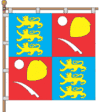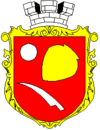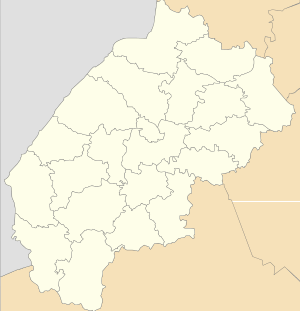Zhydachiv
Zhydachiv (Ukrainian: Жидачів) is a city in Lviv Oblast (region) in western Ukraine. It is the administrative center of the Zhydachiv Raion (district). Local government is administered by the Zhydachivska city council.[1] Its population is approximately 10,962 (2017 est.)[2].
Zhydachiv Жидачів Żydaczów | |
|---|---|
City | |
 Flag  Coat of arms | |
 Zhydachiv Location  Zhydachiv Zhydachiv (Ukraine) | |
| Coordinates: 49°23′06″N 24°08′40″E | |
| Country | |
| Oblast | |
| Raion | Zhydachiv Raion |
| Area | 13 km2 (5 sq mi) |
| Elevation | 261 m (856 ft) |
| Population | 11,180 |
| • Density | 860/km2 (2,200/sq mi) |
| Website | meriya-zhydachiv |
Zhydachiv lies on the Stryi River. It has two schools and one Ukrainian gymnasium.
Name
The city has historically had numerous name variants, reflecting its complex past, including Polish: Żydaczów and Yiddish: זידיטשוב (Zidichov). It was mentioned for the first time in 1164 under the name Udech. In documents from the 14th to 17th centuries, the city was referred to as Zudech, Zudachiv, Sudachiv, Zidachiv, Sidachiv, Zudechev and more.
History

The first written mention of the city dates from the year 1164. At that time the city was part of Galician Rus' and was an important trade center at the confluence of the river Stryi in Dniester with a stone church of St. Nicholas. Then called Udech, Zhydachiv formed from two settlements located at a distance of 800 m from each other. Great western fort occupied territory of present-day mount "Bazyivka" and east fort lies in the mount "Zamok" ("Castle"). Since then (13th century) comes famous miraculous icon of the Virgin Mary that still remains in the city.
Between this two fortifications were also mentioned are six unfortified settlements, which were also included in the structure of the city. Between the two Fortifications on the old river bed (district Korablysche) most likely was located a river harbor, and the district Bologna may be a main shopping area of the ancient Rus' city.
In the mid-14th century, Zhydachiv, together with all of Galicia, was seized by the Kingdom of Poland, then some time became a partin of the Kingdom of Hungary and in 1387 again conquered by Jadwiga of Poland. From 1434 Zhydachiv, was part of Poland's Ruthenian Voivodeship. By the end of 14th century, there were two castles, four Orthodox churches, one Roman Catholic church, a Market Square and a wooden Town Hall. King Wladyslaw Jagiello granted in 1393 Magdeburg rights and several privileges, also founding a Roman Catholic church. Zhydachiv for centuries remained in private hands, among others it belonged to the noble Rzewuski family, had a defensive castle and was the seat of a starosta.
In the middle of the 17th century, population of Zhydachiv participated in the Khmelnytsky Uprising also known as the liberation war led by Bohdan Khmelnytsky.[3] In 1772, it was seized by the Habsburg Empire, as part of Austrian Galicia and in 1800 a Jewish rabbinical School was established.
From 1 November 1918 until May 1919, it was administered by the West Ukrainian People's Republic. After the Polish–Ukrainian War, Zhydachiv became a part of Second Polish Republic and was the seat of a county in Stanislawow Voivodeship. In 1929, the population of Zhydachiv was almost 4,200 including 1,960 Ukrainians, 1,290 Poles and a quarter of the total population (950 members) were the Jews.[4] In September 1939, Zhydachiv was occupied by the Red Army. Soviet authorities deported the Polish residents to Siberia. When the Germans occupied the town in 1941–1944, they kept Jews imprisoned in a ghetto. In September 1942, they were deported to the Bełżec extermination camp and murdered.[5]
After World War II, the city was incorporated into the Ukrainian Soviet Socialist Republic, and from that time started a process of industrialization. In 1951, Zhydachiv become a home of Ukraine's largest pulp and paper mill, which produces 90% of Ukrainian paper.[6] The population has increased fivefold. After 1991, Zhydachiv has been a city in independent Ukraine as the center of the Zhydachiv Raion in Lviv Oblast.
See also
References
- Zhydachivska city council Archived December 10, 2014, at the Wayback Machine
- "Чисельність наявного населення України (Actual population of Ukraine)" (in Ukrainian). State Statistics Service of Ukraine. Retrieved 26 August 2017.
- В. Р. Янклевич, Жидачів. Енциклопедія сучасної України
- http://moreshet.pl/he/node/732
- http://www.sztetl.org.pl/en/article/zydaczow/5,history/
- Целюлозно-паперова промисловість (kmu.gov.ua)